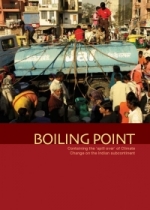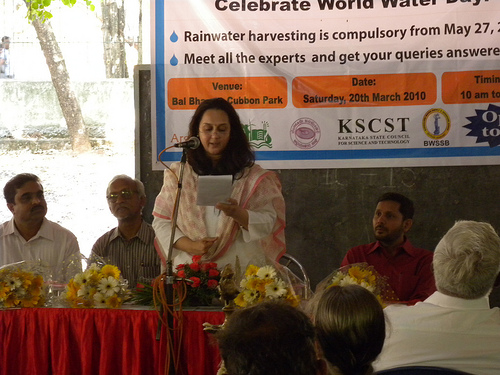News and Articles
Best practices for water management at a household and residential layout-level in Bangalore - A note by Biome
Posted on 09 Apr, 2010 02:07 AMThese two documents enlist best practices in urban water management, based on the experiences of Biome Solutions, and are relevant for households in a gated layout/group housing complex, where the water sourcing, supply and management is in the hands of the layout and there is no connection to the the local water supply authority.
Calculating production cost of water in an urban residential layout setting - A spreadsheet-based toolkit by Biome
Posted on 08 Apr, 2010 10:47 PMBased on the annual costs of imported (purchased) water, pumping (energy), water supply infrastructure and borewell maintenance, wastewater treatment, human resources, rainwater harvesting maintenance, sinking fund (cost of replacement of infrastructure), this spreadsheet-based toolkit by Biome Solutions, helps calculate the total cost (in Rs/KL) of water.
An ecological framework for water management in a domestic context - A spreadsheet-based toolkit by Biome
Posted on 08 Apr, 2010 10:43 PMBased on user-entered data on domestic water demand, waste water discharge, rainfall availability and recharge, extent of reuse of treated waste water, this spreadsheet-based toolkit developed by Biome Solutions allows you to juggle around with the relevant data fields, and figure out various ways in which you can bring down your overall groundwater draft (and hence ecological footprint) as low as possible, and gives a snapshot result of your overall household-level water input and output situation.
Boiling Point: Containing the spill over of climate change in the Indian subcontinent - A report by Sustainable Environment and Ecological Development Society (SEEDS)
Posted on 08 Apr, 2010 02:07 PM The report ‘Boiling Point’ by Sustainable Environment and Ecological Development Society (SEEDS) discusses the impact of climatic changes at the global, national and local level on the environment and on the current survival, food, water security issues and livelihoods of communities in India.
The report ‘Boiling Point’ by Sustainable Environment and Ecological Development Society (SEEDS) discusses the impact of climatic changes at the global, national and local level on the environment and on the current survival, food, water security issues and livelihoods of communities in India.
The report highlights the problems faced by a number of communities from the different parts of the country by presenting case studies that describe how climatic changes have influenced local livelihoods and survival needs of communities with the marginalised and the deprived being the most affected. The report presents a few case studies that illustrate how people have coped with these problems by finding out appropriate, locally relevant and sustainable solutions.
The report recognises that identification of positive efforts made by individuals or groups of people through the case studies can be one such step towards triggering a discussion and educating the people on the seriousness of the situation and making them realise of the urgency to act fast. The report identifies the need for advocacy and educational efforts based on the bottom up approach involving the grassroot level that can lead to building up of pressure for the need to bring about changes at the policy level.
Longest toilet queue campaign by WaterAid Orissa in Puri
Posted on 07 Apr, 2010 04:06 PMThe World's Longest Toilet Queue on 20th March 2010 at Puri sea beach.
Click on the attachment to read the entire report.
Proceedings of the Rainwater Harvesting Mela 2010 held on the occasion of World Water Day by Arghyam in Bangalore
Posted on 07 Apr, 2010 03:26 PM
Dams, Rivers & People - Feb/March edition of SANDRP newsletter
Posted on 06 Apr, 2010 05:22 PM
A bi-monthly newsletter - Dams, Rivers & People: February / March 2010 issue of the newsletter
Hihghlights
- Kerala’s initiative to desilt reservoirs: the Euphoria & the Concerns
- Book Review: Why are the rivers source of conflicts?
- Gujarat makes up stories about Sardar Sarovar Project
- Only 13-17% water losses in Mumbai, Chennai, why not Delhi?
- World Bank’s Double speak on Large Hydro: Renewable or not?
- Pakistan: Glacial lake dam threatens Hunza Valley
Model for self-financing ecological sustainable local development projects for the world's poor - Full year e-learning course
Posted on 03 Apr, 2010 09:01 PMThis website describes the principles and techniques of self-financing, ecological, sustainable local integrated development projects for the world's poor in detail. In each project area with about 50.000 people social, financial, productive and services are set up in a critical order of sequence to ensure a good quality of life everyone, without exclusion, in each project area. The Model gives full coverage to drinking water structures, rain-water harvesting and recycling of grey water for household level cultivation.
NWS has developed a self sustainable flush toilet system - SMARTSAN
Posted on 01 Apr, 2010 01:38 PMEXECUTIVE SUMMARY
Introduction
It is a well documented fact that the combination of safe drinking water and hygienic sanitation facilities is a precondition for health and for success in the fight against poverty, hunger, child deaths and gender inequality. Yet 2.6 billion people – half the developing world – lack even a simple ‘improved’ latrine. One person in six – more than 1 billion of our fellow human beings – has little choice but to use potentially harmful sources of water.